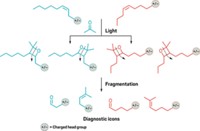Advertisement
Grab your lab coat. Let's get started
Welcome!
Welcome!
Create an account below to get 6 C&EN articles per month, receive newsletters and more - all free.
It seems this is your first time logging in online. Please enter the following information to continue.
As an ACS member you automatically get access to this site. All we need is few more details to create your reading experience.
Not you? Sign in with a different account.
Not you? Sign in with a different account.
ERROR 1
ERROR 1
ERROR 2
ERROR 2
ERROR 2
ERROR 2
ERROR 2
Password and Confirm password must match.
If you have an ACS member number, please enter it here so we can link this account to your membership. (optional)
ERROR 2
ACS values your privacy. By submitting your information, you are gaining access to C&EN and subscribing to our weekly newsletter. We use the information you provide to make your reading experience better, and we will never sell your data to third party members.
Analytical Chemistry
Small Molecules Unmasked In Mass Spectrometry
Deuterated matrix allows researchers to probe small-molecule pharmaceuticals with MALDI mass spec
by Journal News and Community
August 6, 2012
| A version of this story appeared in
Volume 90, Issue 32
Matrix-assisted laser desorption/ionization (MALDI) mass spectrometry is useful for probing biomolecules heavier than 600 daltons, but it struggles to analyze small molecules. Now, researchers have discovered that simply deuterating the MALDI matrix allows them to identify previously hidden small molecules, including neurotransmitters and pharmaceuticals (Anal. Chem., DOI: 10.1021/ac301498m). In MALDI, clusters of matrix molecules often mask the signal of small molecules. Mohammadreza Shariatgorji, a postdoctoral researcher in Per E. Andrén’s medical mass spectrometry lab at Uppsala University, in Sweden, decided to alter the matrix signals slightly to uncover the signals of small molecules known to be hidden by certain matrix clusters. He and his colleagues replaced four aromatic hydrogens with deuterium in a standard matrix material, α-cyano-4-hydroxycinnamic acid (CHCA). The isotopes shifted the matrix peaks by 4, 8, or 12 Da for CHCA and for clusters of two or three CHCA molecules, respectively. To demonstrate the technique, Shariatgorji and his colleagues used it on rat tissue samples to identify three small molecules: a natural product, berberine; a synthetic drug, amiloride; and a neurotransmitter, acetylcholine.





Join the conversation
Contact the reporter
Submit a Letter to the Editor for publication
Engage with us on Twitter